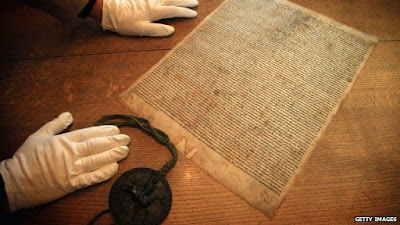On Monday we went to see the Magna
Carta exhibit at the Canadian Museum of History. Understandably, they
did not allow any photography of the two charters (Magna Carta and
Charter of the Forests).
The importance of Magna Carta cannot
be overstated. Among the key principles are:
- Nobody is above the law of the land: The basis of equal justice at all levels
of society.
- Habeas Corpus: Freedom from unlawful detention without
cause or evidence.
- Trial by jury: Rules to settle disputes between barons
and the Crown established trial by a jury of one’s peers.
- Women's rights: A widow could not be forced to marry and
give up her property – a major first step in women's rights.
- Taxation: No
taxation without the consent of the people.
The Charter of the Forests provided rights, privileges and protections
for the common man against the abuses of the aristocracy. At a time when the lands were
the most important potential source of fuel for cooking and heating,
and of industries such as charcoal burning, as well as of collecting
firewood, grazing, or of cutting of turf for fuel, this charter provided a
degree of economic protection for free men.
The exemplars on display in Ottawa were issued in 1300 and bear the seal of King Edward I. Durham Cathedral is the keeper of both these charters.
It was impressive to see the 715-year
old documents. The dimensions of Magna Carta are about
18" by 20", and the Charter of the Forests is a bit smaller.
If you wonder whether these documents are important, just ask yourself whether you'd rather live within the Anglosphere (UK, Canada, USA, Australia, New Zealand, etc.) or in any of Saudi Arabia, Syria, China, Russia, Nigeria, etc.
(John Robson has a good explanation of Magna Carta here.)

